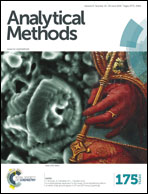Facile synthesis of a highly SERS active nanosilver sol using microwaves and its application in the detection of E. coli using Victoria blue B as a molecular probe†
Abstract
A rapid and green microwave procedure was developed to synthesize highly surface-enhanced Raman scattering (SERS) active silver nanoparticles (AgNPs), using diethanolamine as a reducing agent, that had a surface plasmon resonance (SPR) absorption peak at 444 nm and a resonance Rayleigh scattering (RRS) peak at 450 nm, and a new SERS enhancement mechanism was proposed for the AgNPs–NaCl–AgNO3 system. Bacteria, which were stained using Victoria blue B (VBB), possess the characteristics of a SERS molecular probe in the AgNP sol substrate, with a strong SERS peak at 1611 cm−1 and a peak intensity linear to E. coli concentration in the range of 5 × 106 to 3 × 109 colony forming units per mL (cfu mL−1). This new, simple, rapid and sensitive SERS quantitative analysis method was used for detecting E. coli in real samples.


 Please wait while we load your content...
Please wait while we load your content...